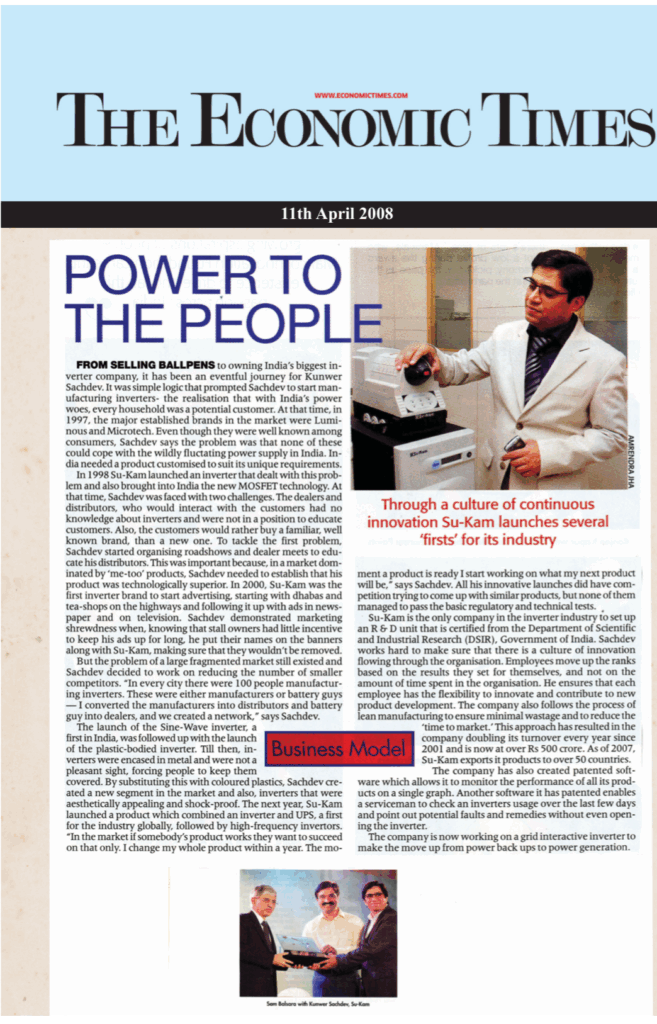An article in THE ECONOMIC TIMES written by AMRENDRA JHA
11th April 2008
POWER TO THE PEOPLE
FROM SELLING BALLPENS to owning India’s biggest inverter company, it has been an eventful journey for Kunwer Sachdev. It was simple logic that prompted Sachdev to start manufacturing inverters the realization that with India’s power woes, every household was a potential customer. At that time, in 1997, the major established brands in the market were Lumi-nous and Microtech. Even though they were well known among consumers, Sachdev says the problem was that none of these could cope with the wildly fluctuating power supply in India. India needed a product customized to suit its unique requirements.
In 1998 Su-Kam launched an inverter that dealt with this problem and also brought into India the new MOSFET technology. At that time, Sachdev was faced with two challenges. The dealers and distributors, who would interact with the customers had no knowledge about inverters and were not in a position to educate customers. Also, the customers would rather buy a familiar, well-known brand, than a new one. To tackle the first problem, Sachdev started organizing roadshows and dealer meets to educate his distributors. This was important because, in a market dominated by ‘me-too’ products, Sachdev needed to establish that his product was technologically superior. In 2000, Su-Kam was the first inverter brand to start advertising, starting with dhabas and teashops on the highways and following it up with ads in newspaper and on television. Sachdev demonstrated marketing shrewdness when, knowing that stall owners had little incentive to keep his ads up for long, he put their names on the banners along with Su-Kam, making sure that they wouldn’t be removed.
But the problem of a large fragmented market still existed and Sachdev decided to work on reducing the number of smaller competitors. “In every city there were 100 people manufacturing inverters. These were either manufacturers or battery guys – I converted the manufacturers into distributors and battery guy into dealers, and we created a network,” says Sachdev.
The launch of the Sine-Wave inverter, a first in India, was followed up with the launch Inverters were encased in metal and were not a pleasant sight, forcing people to keep them covered. By substituting this with colored plastics, Sachdev created a new segment in the market and also, inverters that were aesthetically appealing and shock-proof. The next year, Su-Kam launched a product which combined an inverter and UPS, a first for the industry globally, followed by high-frequency invertors. “In the market if somebody’s product works, they want to succeed on that only. I change my whole product within a year. The moment a product is ready I start working on what my next product will be,” says Sachdev. All his innovative launches did have competition trying to come up with similar products, but none of them managed to pass the basic regulatory and technical tests.
Through a culture of continuous innovation Su-Kam launches several ‘firsts’ for its industry
Su-Kam is the only company in the inverter industry to set up an R & D unit that is certified from the Department of Scientific and Industrial Research (DSIR), Government of India. Sachdev works hard to make sure that there is a culture of innovation flowing through the organization. Employees move up the ranks based on the results they set for themselves, and not on the amount of time spent in the organization. He ensures that each employee has the flexibility to innovate and contribute to new product development. The company also follows the process of lean manufacturing to ensure minimal wastage and to reduce the ‘time to market. This approach has resulted in the company doubling its turnover every year since Su-Kam exports it products to over 50 countries. The company has also created patented software which allows it to monitor the performance of all its products on a single graph. Another software it has patented enables a serviceman to check an inverters usage over the last few days and point out potential faults and remedies without even opening the inverter. The company is now working on a grid interactive inverter to make the move up from power backups to power generation.
of the plastic-bodied inverter. Till then, in- Business Model 2001 and is now at over Rs 500 crore. As of 2007,
